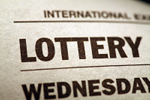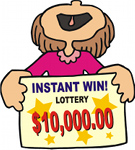
Grades 9-12

Don't have an account yet? Sign up for free
Don't have an account yet? Sign up for free

Friday the 13th was your lucky day. You won the lottery! The lottery officials have given you a choice. You can either receive the $10 million now in one lump sum, or you can receive $1 million a year for the next 20 years. Now what do you do?
Do you take the $10 million in one lump sum payment? Or do you take the yearly payments for the next 20 years? If you take the lump sum payment, you can pay for college, take trips anywhere in the world, and enjoy the good life. If you take the payments, you will have a guaranteed income for the next 20 years. Making decisions between two time periods is hard because the costs and benefits arrive at different times. In this lesson, you will learn how to apply the concept of present value to determine the best way to receive your lottery winnings.
 Grab your Ti-83 graphing calculator or find an Excel spreadsheet and we will make short work of this problem.
Grab your Ti-83 graphing calculator or find an Excel spreadsheet and we will make short work of this problem.
You will solve the lottery problem presented in the introduction to this lesson. Using Excel software or your graphing calculator should allow you to focus solely on solving the dilemma.
You will have an assignment very similar to complete that will reinforce the concepts of present value to make decisions in two different time periods.
If your teacher requires it, you will have the opportunity to look at some people who won the lottery and see if the decisions they made to receive their lottery winnings was the right one.
Playing the lottery has a low probability of winning. This lesson is used to teach the concepts of present and future value and not to promote the playing of the lottery. This https://answers.yahoo.com/question/index?qid=20081017201927AASy801&guccounter=1 will provide students with more information about the probabiltity of winning the lottery.
The use of present value and future value are used extensively in financial markets. For example, these concepts are used by consumers to decide whether to buy or rent. Students will find that they can make many financial decisions using these concepts including how to buy bonds and mortgages.
In this lesson you will use technology to determine the best payoff in present value terms, and make predictions about the present value based on the interest rate.
As you have seen in this lesson, the interest rate plays a huge part in determining whether to take a lump sum payout or receive annual payments. The higher the interest rate, the lower the lump sum payment.
You can apply this concept to deciding whether to go to work now or college or any decision in which costs and benefits come at different times.
The use of present value has many uses in accounting, investing, and making decision where the benefits arrive at different times. Recently, I bought a saving bond for $25. At maturity the bond will be worth $50. The government used present value to determine the length of time and interest rate on this bond.
Your best friend in the whole world has just won the scratch-off lottery that promises to pay him $30,000. Your friend has been told that he must take three yearly payments of $10,000 each. He knows that you have a huge savings account and says to you, “Here. I’ll give you my lottery ticket and you give me $30,000. It’s the same thing.” 
1. Evaluate your friend’s offer. (HINT: Economists like to say that a dollar today is worth more than a dollar tomorrow because the dollar today can earn interest.)
2. If the interest rate is 10%, calculate the present value of receiving $10,000 per year for three years, compounded annually.
3. If the interest rate is 5%, calculate the present value of receiving $10,000 per year for three years, compounded annually.
4. Should you take the lottery ticket if the interest rate is 10%?
5. Should you take the lottery ticket if the interest rate is 5%?
6. If the interest rate is high, say 20%, will the present value of a payment in the future be large or small?
Read this story by Doug Alden, AP, July 31, 1998. The entire story is https://www.courant.com/news/connecticut/hc-xpm-1998-07-31-9807310226-story.html .
After years of pooling money to buy lottery tickets, a group of machinists who call themselves “The Lucky 13” stepped forward yesterday to claim the biggest prize yet – the $295.7 million Powerball jackpot.
One of the 13 workers at Automation Tooling Systems in this Columbus suburb drove 100 miles to buy 130 tickets just over the Indiana line for Wednesday’s drawing.
“It took a long time to believe we actually hit it,” said John Jarrell, a burly man with a long mustache who was the first of the 13 men to identify himself. “You go from totally excited to scared to death.”
The Lucky 13 won’t officially be the winners until the Indiana lottery office validates the ticket. The jackpot was worth $295.7 million in payments over 25 years, but the winners took the cash option – one payment of about $161.5 million, Indiana lottery officials said. The Lucky 13 intend to split the money evenly, for $12.42 million per person before taxes, their lawyer said.
If one multiplies $11.8 million by 25 years, the answer is $295 million. Assume that $295 million is the future value of the lottery winnings. If the interest rate is compounded annually for 25 years and the winners receive one payment a year, calculate the interest rate.

Grades 9-12

Grades 9-12

Content Partner
Grades 9-12

Content Partner
Grades 9-12
